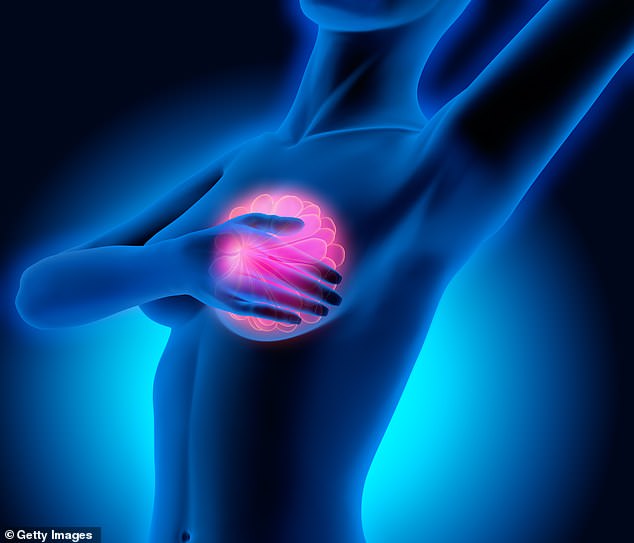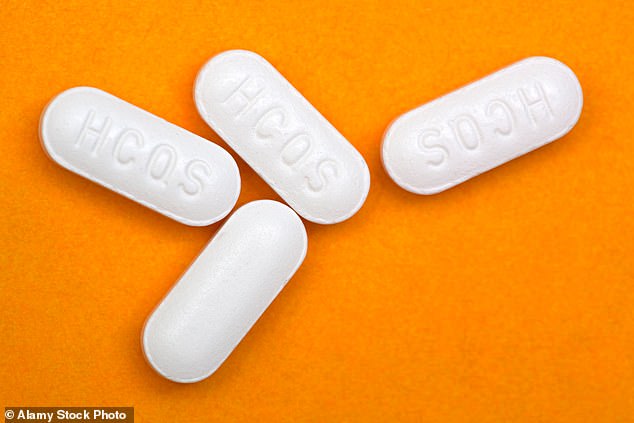A drug that costs 5p per tablet and is already widely used to treat malaria may also cut the chances of breast cancer recurring.
Scientists at Penn Medicine Abramson Cancer Center and the University of Pennsylvania, both in the US, have found that hydroxychloroquine – used since the 1950s to prevent and treat mosquito-borne malaria – seems to be highly effective at wiping out breast cancer cells left behind after women are treated for the disease.
These cells can remain undetected in bone marrow and elsewhere in the body, before later proliferating and causing a return of the breast cancer.
An estimated 40 per cent of women successfully treated for primary breast cancer retain traces of these inert ‘sleeper cells’ when they go into remission.
And for one in five of them, the disease returns, often within a few years of their initial illness.
While breast cancer is treatable with surgery, radiotherapy and chemotherapy, when it recurs it is almost always considered a chronic disease and, ultimately, terminal.
Lewis Chodosh, a professor of cancer biology and medicine at the University of Pennsylvania and a lead author of the new study, told Good Health these dormant cells ‘have been largely ignored by medics in the past’.

An estimated 40 per cent of women successfully treated for primary breast cancer retain traces of these inert ‘sleeper cells’ when they go into remission
‘Wiping out these dormant cancer cells in their sleeper phase represents an opportunity to eradicate them before they have the chance to come back as aggressive, metastatic disease [cancer that has spread].
‘Surprisingly, we’ve found that certain drugs that don’t work very well against actively growing cancers can be very effective against these sleeper cells. This tells us that the biology of dormant tumour cells is very different from active cancer cells.’
Women in remission from breast cancer may currently receive hormone-suppressing drugs, including letrozole and tamoxifen, to try to reduce the risk of the cancer coming back.
‘But they do not directly target cancer cells,’ says Professor Chodosh. ‘Instead, these drugs aim to reduce the levels of a woman’s own hormones that likely contribute to the growth of some tumours.’
In malaria, hydroxychloroquine kills the parasites that cause infection, making them more alkaline and so unable to break down haemoglobin in red blood cells, which they need to do to replicate.
But the discovery that it can also wipe out dormant breast cancer cells could help transform treatment of the disease.
Professor Chodosh says it seems to work by blocking autophagy, the process by which a cell ‘recycles’ its used parts and breaks down old, damaged or abnormal proteins and other substances.

Scientists in the US have found that hydroxychloroquine (pictured) – used since the 1950s to prevent and treat mosquito-borne malaria – seems to be highly effective at wiping out breast cancer cells left behind after treatment
Although autophagy is a natural process, in a cancer cell it can promote growth, because those damaged elements are turned into energy and nutrients that help the cancer flourish.
This ability to inhibit autophagy is already being studied in other cancers, such as bone cancer.
‘Although hydroxychloroquine is effective against dormant cancer cells, it doesn’t seem to be effective at killing breast cancer cells when they are active and replicating rapidly, for reasons not yet fully understood,’ says Professor Chodosh.
In the recent study, women who had been in remission for at least five years were given annual bone marrow tests – where liquid bone marrow is removed via a needle from the hip.
If they were found to have dormant breast cancer cells in their bone marrow, they were enrolled in the trial and given hydroxychloroquine or everolimus (an NHS treatment offered for advanced breast cancer, which works by blocking a protein called mTOR), or both drugs at the same time.
Angela DeMichele, professor of medicine and epidemiology at the University of Pennsylvania, and co-lead of the study, told Good Health: ‘We identified [dormant] cells in approximately 25 per cent of the women we tested and for some [of those] patients who have the cells they will never reactivate.’
The team had hoped hydroxychloroquine might get rid of the dormant cells in about 25 per cent of the patients. In fact, it did so in 80 per cent who had them.
‘This far exceeded our hopes,’ says Professor DeMichele.
In the study, 42 months after starting the treatment, 91.7 per cent of the women on hydroxychloroquine showed no sign of any cancer cells; the figure was 92.7 per cent for those on everolimus and 100 per cent for the women taking both drugs.
Professor Chodosh suggests that in future, these types of tests might be offered to all women in remission after their initial breast cancer diagnosis, although this would likely mean developing a more sensitive test – something he is now working to develop with colleagues.
Professor DeMichele said: ‘The lingering fear of cancer returning is something that hangs over many breast cancer survivors.’
According to recent research by the charity Breast Cancer Now, up to 86 per cent of breast cancer patients experience some level of this fear.
For some people, it can be debilitating, leading to chronic distress, depression and anxiety.
Dr Kotryna Temcinaite, the charity’s head of research communications, told Good Health: ‘We know that sometimes breast cancer cells escape initial treatment and can remain inactive and undetected for years before developing into secondary breast cancer.
‘In this clinical trial, researchers have shown that it’s possible to target inactive breast cancer cells. Now we need a larger clinical trial to see if these treatments can stop secondary breast cancer developing and save lives.’
She said there are limitations to this approach, for example: ‘It is difficult to find dormant breast cancer cells in bone marrow samples, because these cells can be so few’.